Palace Theatre (Marion, Ohio)
| Palace Theatre | |
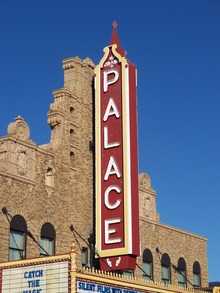 Marion Palace Theatre, Marion, Ohio | |
| Address |
233 West Center Street Marion, Ohio United States |
|---|---|
| Owner | Palace Cultural Arts Association |
| Type | Movie Palace atmospheric theatre |
| Capacity | 1,440 |
| Current use | Performing arts center |
| Construction | |
| Opened | August 30, 1928 |
| Rebuilt | 1975-1976 |
| Architect | John Eberson |
| Website | |
|
Marion Palace Theatre | |
 | |
| Coordinates | 40°35′19″N 83°8′01″W / 40.58861°N 83.13361°WCoordinates: 40°35′19″N 83°8′01″W / 40.58861°N 83.13361°W |
| Built | 1928 |
| Architectural style | Late 19th and 20th century Spanish Revival, atmospheric theatre |
| Governing body | Private |
| NRHP Reference # | 76001486[1] |
| Added to NRHP | 1975 |
The Marion Palace Theatre in Marion, Ohio is a movie palace constructed in 1928. It is listed on the National Register of Historic Places because of its significance to the atmospheric theatre architectural style popular in the United States during the 1920s.
The theatre was constructed for the Young Amusement Company (Gary, Indiana) and opened on August 30, 1928, becoming the company's tenth theatre.[2] A movie palace, it was one of the last to be built in the atmospheric theatre style in the United States.[3] In addition to motion pictures and newsreels, the theatre also booked vaudeville and legitimate theatre, although vaudeville had declined in popularity by the time the theatre opened.[4]
It is located at the corner of West Center Street and Campbell Streets, on two former residential lots. The site was initially owned by the Campbell family, early Marion settlers. The lot slopes to the west, causing the stage to be below grade level on the east and at grade level on the west. The east lot was vacant at the time of construction, while the west lot had a residential house, which was razed. Over time, additional land was secured and added to the complex.
In 1975, the theatre was sold to the Palace Cultural Arts Association, a nonprofit organization, and renovated. The Palace remains open today as a movie and performing arts center, and is one of 16 atmospheric theatres designed by John Eberson that remain in operation as theatres in the United States.[5]
Architecture
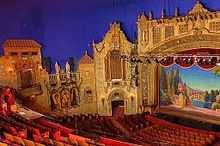
The Marion Palace was designed by John Eberson as an atmospheric theatre. Eberson designed it as, in the words of V.U. Young, the theatre owner, “A Spanish Castle” or “A Palace in Old Spain.”[6] It is difficult to assign an Eberson theatre to a precise architectural style. Eberson "mixed architectural styles, more interested in evoking an impression than precisely replicating an architectural period." [7] The theatre is best described as designed in the Spanish Colonial Revival architecture style.[8] Spanish Colonial Revival was popular in Florida during the 1920s, and features arches, terra-cotta roof tiles, towerlike structures, balconies, ornamental ironwork, courtyards, patios and arcades. The design influence of the Spanish architect José Benito de Churriguera is prevalent. This Churrigueresque revival style is seen in the pillars to the right of the stage, the proscenium details, and in Eberson’s use of balustrades, stucco shells and garlands.[7] The outside is designed to resemble a palace exterior. Inside, Eberson transitions the patrons from a lobby through wooden doors to an arcade (at the rear of the orchestra) and into a courtyard on a hill. From the balcony, patrons are surrounded by a Spanish town wall and have the same view a resident would have from a high building looking down on the courtyard. A blue sky above creates the impression of open space. Stars are designed in constellation patterns in the ceiling and twinkle through holes in the plaster during performances. A Brenkert Brenograph Jr. projector, hidden in the east side wall, projects clouds on the ceiling, further creating an outdoor illusion.[9]
Opening Night
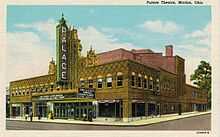
_01.jpg)
On August 30, 1928, the Marion Palace Theatre opened to a packed house for two performances.[10] At the first performance, Colonel George B. Christian gave a brief opening address.[11] The father of President Warren G. Harding’s secretary, George B. Christian Jr., the elder Christian was actively involved in Marion’s civic life.[12] His remarks included a short history of theatres in Marion, and he praised the beauty of the building.[12] John Eberson then made a few remarks and introduced Young.[12] He presented Young with a bag of birdseed, a tongue-in-cheek reference to the stuffed pigeons that Eberson had installed to create the feeling of being outdoors at the Palace.[13] The entertainment began with organ music by Banks Kennedy, a well-known Chicago organist.[14] He had written a new composition, which he titled “Everybody’s Welcome to the Palace.” [12] Next was a theatre overture, “A Night in the Clock Store,” by the Palace Orchestra under the direction of Elmer Newstrom. Four vaudeville acts followed: Harry Kahne, a nationally known mental wizard; Tilyou and Rogers, a comedy team; Johnny Mack and Company (including Ethel Dunton, Dolly Moran and Shirley Manion); and the Castlemans, a trio of entertainers. Following the live acts, a Metro-Goldwin-Mayer silent picture, Excess Baggage (1928 film), starring William Haines, Josephine Dunn and Ricardo Cortez, was shown.[12] The film is now lost.[15] The owner had hoped to open the theatre with the new "talkie" equipment.[16] While the theatre was pre-wired for sound motion pictures, the equipment did not arrive until the following year.[17]
Upon opening in 1928, the theatre was immediately embraced by patrons.[18] The day before the opening, the local newspaper, The Marion Star described the Palace:
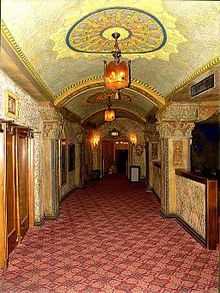
Forget for a few minutes that you are reading a copy of your evening paper. Allow your imagination to carry you to the gentle slope of a moon-lit Spanish hill. Before you rise [sic] a vine covered garden wall, broken here and there with graceful arches. Through the archways spreads the soft light of a harvest moon and the dim glow casts shadows over the somber colored walls. Overhead myriads of stars are twinkling in an azure blue sky and soft, fleecy clouds are drifting gently with the breeze. Picture all this in your mind and you have a fair conception of the interior of the Palace theater—Marion’s new half million dollar playhouse. The new theater is Spanish in design in all its details. From the walls and the mural decorations to the reproduction of period furniture in the lounges the Spanish design is followed. Before going to the Palace for the first time Thursday night it might be well to take a word tour through the new playhouse. The box office is approached directly from the street. Inside double swinging doors is the lobby. After passing through more double doors one enters the foyer and the theater proper. The doors separating the foyer and the lobby are made of heavy walnut and are in keeping with the interior decorations. Deep grooves line their surface, giving them a weather-beaten appearance. Small openings near the top are barred with iron gratings. ... Opportunities for carrying out the Spanish effect in the mezzanine floor are even greater than in the foyer. Here the designer of the theater has let his fancy take full flight. Here and there patches of red brick appear, as through [sic] the plaster had fallen from the walls. A niche in the wall is cleverly adapted to hold a drinking fountain. The view from the balcony is even better than the lower floor. As in the lower floor view of the stage is unobstructed by pillars. [T]he balcony being of cantilever construction removes the necessity of supporting it with posts and pillars which necessarily cut off the view of the unfortunate patron who is forced to sit behind one.[18]
Pietro Caproni Statues
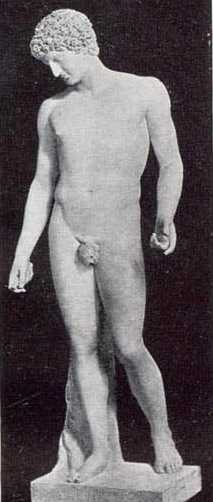
The illusion of a courtyard setting is further enhanced by the beautiful plaster cast statues that are strategically placed throughout the Palace. Almost all of these are originals produced by Pietro Caproni (1862–1928) and his firm, P.P. Caproni and Brother. With his brother, Emilio, the Caproni firm supplied plaster cast sculptures to schools, museums and theatres throughout America, including Symphony Hall, Boston. Eberson used them in all of his atmospheric theatres. Caproni believed that “the quality of a reproduction is of the greatest importance. In an original work of merit there is a subtleness of treatment—a certain feeling which, if captured in reproduction, places the finished piece within the realm of art itself.” The statues installed at the Palace are castings of classical Greek and Roman works, including the Praying Boy, the Capitoline Antinous, Doryphoros and Diana of Versailles. A casting of Lorado Taft's George Washington, dressed in Revolutionary War clothing is located in a balcony niche.[19]
The image to the right is a representation of the Caproni casting for the Capitoline Antinous, which is located at the Palace in a niche in the upper right hand corner of the north wall, above the proscenium. To the left of this statue is a Caproni plaster casting of the Praying Boy.
Theatre Organ
A Page Rainbo Gold organ was installed when the Palace opened. Manufactured by the Page Organ Company of Lima, Ohio, it was first played by Banks Kennedy, who was the guest organist at the Palace until December 1928. That organ was sold and was replaced with a 3/10 Mighty Wurlitzer Theatre Pipe Organ, installed in 1976. At the opening, the Marion Star described the Page organ to its readers:
"Organs of exquisite tone and ornate appearance have become one of the outstanding features of motion picture houses and the management of Marion’s new playhouse invested a huge sum in obtaining one of the best on the market. The organ is custom made being designed especially for the Marion theater. The size of the building and its acoustic properties were taken into consideration before any work was done on the musical instrument. Every bit of material going into the construction of the organ was carefully selected coming from many lands. Many weeks of work were necessary before the instrument was completed and ready to install. The heart of the organ rests in the switchboard. Keys operate silver and bronze contacts making instantaneous connections with the pipes and other effects. The pipes are cleverly concealed on each side of the stage, the opening forming double windows leading to balconies of two Spanish towers. The chambers form a natural part of the architecture of the interior. The console is the only part of the huge organ visible. It rests on a platform that can be raised and lowered bringing the console up to a point where it can be viewed to a great advantage all over the house or lowered to a point where it does not interfere with the view of the stage. The elevator is controlled by a motor located in a soundproof room back of the stage. The console itself is known as the Page Rainbo Gold deriving its name from the finish. It is heavily scrolled and so finished that lights are reflected in a very effective fashion."[20]
Restoration
The theatre seats 1420 patrons (originally the theatre had seats for 1540 patrons).[21] Originally, retail space was rented to four businesses on the street level and a medical clinic and beauty shop on the second floor level.[22] These spaces have been remodeled for a concession stand, a box office, theatre offices and multi-purpose spaces.
Restoration work on the Palace is ongoing. It was completely restored in 1975-1976 after ownership was transferred to a local nonprofit group, the Palace Cultural Arts Association. John Eberson’s son, Drew Eberson,[23] helped guide the restoration. Since that time, the building has undergone a series of backstage and front of house improvements. The Palace board estimates that ongoing maintenance and renovation will cost an additional $1.4 million. The Board of Directors instituted a Capital Improvement Fee that is charged with each ticket; funds from this fee are deposited in a funded depreciation account. Additional capital funds are made available from a $1 million endowment fund that is managed by the Marion Community Foundation. Areas still to be addressed include facade repairs and decorative painting. The theatre directors kicked-off a public fundraising campaign in December 2014 and hope to complete work by the end of 2016.[24]
Pavilion
An adjoining, two-story, 15,300 square foot building annex, in the style of a hotel ballroom, was completed in 2008. Funded, in part, by a generous grant from the State of Ohio and local donors, the Albert & Ingrid May Pavilion is named for two philanthropists, a local physician and an educator. Some of the donors are recognized with stars on nearby sidewalks, although not every person or company recognized donated money. The building provides space for small theatrical productions, chamber orchestras, bands, wedding receptions, meetings and business, civic and social events.[25]
Historical Information and Archives
The Palace Cultural Arts Association maintains a small archive of Palace artifacts and photos. Also, the Marion County Historical Society maintains a collection of Palace photographs and theatre memorabilia. Finally, the Theatre Historical Society of America has a collection of Palace photographs.
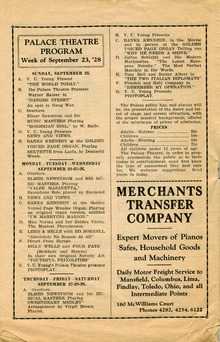
The Palace Theatre and Hiroshi Sugimoto
The Palace Theatre is one of the movie palaces photographed by Hiroshi Sugimoto (杉本博司, Sugimoto Hiroshi), a Japanese photographer.[26] In 1978, Sugimoto's Theatres series [27] involved photographing old American movie palaces and drive-ins with a folding 4x5 camera and tripod, opening his camera shutter and exposing the film for the duration of the entire feature-length movie, the film projector providing the sole lighting. The luminescent screen in the center of the composition, the architectural details and the seats of the theatre are the only subjects that register owing to the long exposure of each photograph, while the unique lighting gives the works a surreal look, as a part of Sugimoto's attempt to reveal time in photography.[28] Sugimoto disovered that "Different movies give different brightnesses. If it's an optimistic story, I usually end up with a bright screen; if it's a sad story, it's a dark screen. Occult movie? Very dark."[29]
The Singin' Cowboy Premiere
The musical "The Singin' Cowboy" had its world premiere in August, 2011 at the theatre. Under the direction of Tina Salamone, it played for six performances. The musical is by Todd Mueller; story by Todd Mueller, Hank Boland and Gregg Opelka; music and lyrics by Gregg Opelka; book by Todd Mueller; and additional dialogue by Hank Boland. The romantic comedy is an homage to the great characters of movie Westerns. It tells the tale of a hero named Singin’ who sets out to capture and bring to justice the fiercest outlaws in the land, Tumbleweed Tammy and her bumbling gang. It includes the romantic song "Five Minutes 'til Midnight" and the hilarious chorus number "A Beautiful Day for a Hangin'."[30]
Current Use
The theatre is owned by a nonprofit corporation and governed by a board of directors. The board is elected by members at an annual meeting. The theatre presents touring artists and children's theatre. During the off-season and at other times during the year when the theatre would be otherwise dark, amateur theatre and high school productions are presented on the main stage and in the smaller May Pavilion. The theatre also exhibits current motion pictures and is adding a digital projection system that was funded by generous donations by local trusts and by member donations.
References and Footnotes
Hoffman, Scott L. A Theatre History of Marion, Ohio: John Eberson's Palace and Beyond. Charleston, SC: The History Press, 2015. ISBN 978-1626199507
Levin, Steve. A John Eberson Scrapbook. Theatre Historical Society of America 27 (2000).
Luna, T.P. “Those Enterprising Exuberant Ebersons.” Marquee 25, no. 1 (1991): 25–30.
Williams, Celeste M., and Dietmar E. Froehlich. “John Eberson and the Development of the Movie Theater: Fantasy and Escape.” in Contribution and Confusion: Architecture and the Influence of Other Fields of Inquiry. Paper presented at 91st ACSA International Conference, Helsinki. Association of Collegiate Schools of Architecture, 2004.
- ↑ "National Register Information System". National Register of Historic Places. National Park Service. 2010-07-09.
- ↑ Motion Picture News, January 7, 1928, 16; Marion Star, August 29, 1928; Hoffman, Scott L. A Theatre History of Marion, Ohio: John Eberson's Palace and Beyond. Charleston, SC: The History Press, 2015, 26-36.
- ↑ Williams, Celeste M., and Dietmar E. Froehlich. “John Eberson and the Development of the Movie Theater: Fantasy and Escape.” in Contribution and Confusion: Architecture and the Influence of Other Fields of Inquiry. Paper presented at 91st ACSA International Conference, Helsinki. Association of Collegiate Schools of Architecture, 2004.
- ↑ http://www.musicals101.com/1927-30film2.htm
- ↑ Hoffman, 2015, p. 67.
- ↑ Marion Star, December 23, 1927, 5.
- ↑ 7.0 7.1 Hoffman, 2015, p. 30.
- ↑ Levin, Steve. A John Eberson Scrapbook. Theatre Historical Society of America 27 (2000).
- ↑ Marion Star, August 31, 1928, 1.
- ↑ Marion Star, Aug. 31, 1928, p. 2; Hoffman, 2015, pp. 32-36.
- ↑ Hoffman, 2015, p. 32.
- ↑ 12.0 12.1 12.2 12.3 12.4 Marion Star, Aug. 31, 1928, p. 2.
- ↑ Marion Star, Aug. 31, 1928, p. 2; Hoffman, 2015, p. 33.
- ↑ Marion Star, August 31, 1928, p. 2.
- ↑ Arne Andersen's Lost Film Files; Library of Congress American Silent Feature Film Survival Guide
- ↑ Marion Star, August 29, 1928, 7; Hoffman, 2015, p. 11.
- ↑ Hoffman, 2015, pp. 27-28.
- ↑ 18.0 18.1 Marion Star, August 29, 1928, 2.
- ↑ Hoffman, 2015, pp. 83-90.
- ↑ Marion Star, August 29, 1928, 7.
- ↑ Hoffman, 2015, p. 71.
- ↑ Hoffman, 2015, pp. 93-98.
- ↑ Luna, 1991, pp. 25–30.
- ↑ Fascade and Sign Renovation Capital Campaign for Marion Palace Theatre
- ↑ http://www.marionpalace.org/pavilion
- ↑ Christies auction of print of Marion Palace Theatre, 26 - 27 September 2013 New York, Rockefeller Plaza ($17,500)
- ↑ Belting, Hans and Hiroshi Sugimoto. Theatres. Koln: Sonnabend Sundell Editions and Eyestorm, 2006. ISBN 9780615115962.
- ↑ Peter Yeoh (2010). "Capturing Light – Hiroshi Sugimoto reveals the essence of his life’s work". Glass Magazine (2): 174–179. ISSN 2041-6318
- ↑ Belting, Hans and Hiroshi Sugimoto. Theatres.
- ↑ "The Signin' Cowboy Musical".